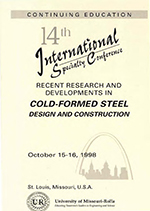Session Dates
15 Oct 1998
Abstract
The buckling behaviour of cold-formed steel columns and beams is far from simple. The three generic forms of buckling, namely local buckling, distortional buckling and overall buckling, generally have different wavelengths and are usually restricted to different span ranges. However, there is also the possibility of interaction among these buckling modes at a certain span length. Thus, local plate buckling and distortional buckling may occur together with lateral-torsional buckling in such a way that they all have an influence on the ultimate load carrying capacity of a member. The influence of local buckling is taken into consideration in design codes by using either an effective width or an effective thickness for the plate element under consideration. However, the consideration of distortional buckling is less-well developed in the codes and the effect of its interaction with other buckling modes is far from clear. Another factor which influences the ultimate load carrying capacity of a thin-walled section is the interaction of compression force and bending moment. In current design codes, this is usually limited by a certain allowable stress in the extreme fibres of the cross-section. For a stocky member which is not subject to buckling, this is a reasonable assumption. However, for potentially unstable members, the behaviour is complicated and, in most cases, the test results are scattered high above the predictions given by the design codes. Generalised Beam Theory (GBT) [1-3] can provide explicit analytical expressions for the problems associated with the various interactions of the alternative buckling modes and also the interactions associated with combinations of axial load and bending. This paper, therefore, makes particular use of GBT in assessing the influence of local buckling and distortional buckling on lateral-torsional buckling and the interaction of compression force and bending moment. Based on analyses using GBT together with comparisons with available test results, conclusions are presented which the authors hope will be of benefit for future design codes.
Department(s)
Civil, Architectural and Environmental Engineering
Research Center/Lab(s)
Wei-Wen Yu Center for Cold-Formed Steel Structures
Meeting Name
14th International Specialty Conference on Cold-Formed Steel Structures
Publisher
University of Missouri--Rolla
Document Version
Final Version
Rights
© 1998 University of Missouri--Rolla, All rights reserved.
Document Type
Article - Conference proceedings
File Type
text
Language
English
Recommended Citation
Jiang, C.; Ungureanu, Viorel; and Davies, J. Michael, "Buckling Mode Interaction in Cold-formed Steel Columns and Beams" (1998). CCFSS Proceedings of International Specialty Conference on Cold-Formed Steel Structures (1971 - 2018). 2.
https://scholarsmine.mst.edu/isccss/14iccfsss/14iccfsss-session1/2
Buckling Mode Interaction in Cold-formed Steel Columns and Beams
The buckling behaviour of cold-formed steel columns and beams is far from simple. The three generic forms of buckling, namely local buckling, distortional buckling and overall buckling, generally have different wavelengths and are usually restricted to different span ranges. However, there is also the possibility of interaction among these buckling modes at a certain span length. Thus, local plate buckling and distortional buckling may occur together with lateral-torsional buckling in such a way that they all have an influence on the ultimate load carrying capacity of a member. The influence of local buckling is taken into consideration in design codes by using either an effective width or an effective thickness for the plate element under consideration. However, the consideration of distortional buckling is less-well developed in the codes and the effect of its interaction with other buckling modes is far from clear. Another factor which influences the ultimate load carrying capacity of a thin-walled section is the interaction of compression force and bending moment. In current design codes, this is usually limited by a certain allowable stress in the extreme fibres of the cross-section. For a stocky member which is not subject to buckling, this is a reasonable assumption. However, for potentially unstable members, the behaviour is complicated and, in most cases, the test results are scattered high above the predictions given by the design codes. Generalised Beam Theory (GBT) [1-3] can provide explicit analytical expressions for the problems associated with the various interactions of the alternative buckling modes and also the interactions associated with combinations of axial load and bending. This paper, therefore, makes particular use of GBT in assessing the influence of local buckling and distortional buckling on lateral-torsional buckling and the interaction of compression force and bending moment. Based on analyses using GBT together with comparisons with available test results, conclusions are presented which the authors hope will be of benefit for future design codes.



